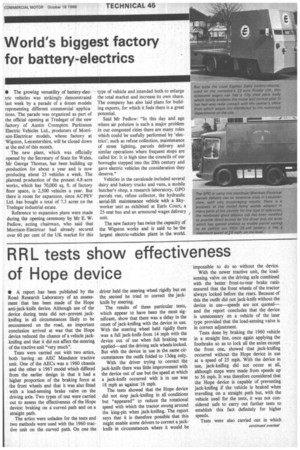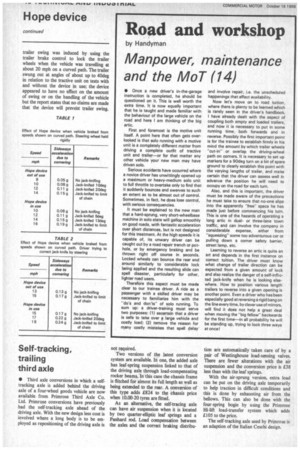RRL tests show effectiveness of Hope device
Page 47

Page 48

If you've noticed an error in this article please click here to report it so we can fix it.
• A report has been published by the Road Research Laboratory of an assessment that has been made of the Hope anti-jack-knife device. Although use of the device during tests did not prevent jackknifing in all circumstances likely to be encountered on the road, an important conclusion arrived at was that the Hope device reduced the chance of a vehicle jackknifing and that it did not affect the steering of the tractive unit "very much".
Tests were carried out with two artics, both having an AEC Mandator tractive unit. One of the AECs was a 1960 chassis and the other a 1967 model which differed from the earlier design in that it had a higher proportion of the braking force at the front wheels and that it was also fitted with a load-sensing brake valve on the driving axle. Two types of test were carried out to assess the effectiveness of the Hope device: braking on a curved path and on a straight path.
The attics were unladen for the tests and two methods were used with the 1960 tractive unit on the curved path. On one the driver held the steering wheel rigidly but on the second he tried to correct the jackknife by steering.
The results of these particular tests, which appear to have been the most significant, show that there was a delay in the onset of jack-knifing with the device in use. With the steering wheel held rigidly there was a full jack-knife from 14 mph with the device out of use when full braking was applied—and the driving axle wheels locked. But with the device in use in the same circumstances the outfit folded to 13deg only.
With the driver trying to correct the jack-knife there was little improvement with the device out of use but the speed at which a jack-knife occurred with it in use was 18 mph as against 16 mph. The tests showed that the Hope device did not stop jack-knifing in all conditions but "appeared" to reduce the rotational speed with which the tractor swung around the king-pin when jack-knifing. The report says that it is therefore possible that this might enable some drivers to correct a jackknife in circumstances where it would be impossible to do so without the device.
With the newer tractive unit, the loadsensing valve on the driving axle combined with the better front-to-rear brake ratio ensured that the front wheels of the tractor always locked before the rears. Because of this the outfit did not jack-knife without the device in use—speeds are not quoted— and the report concludes that the device is unnecessary on a vehicle of the later type provided that the load-sensing valve is in correct adjustment.
Tests done by braking the 1960 vehicle in a straight line, once again applying the footbrake so as to lock all the axles except the front one, showed that jack-knifing occurred without the Hope device in use at a speed of 25 mph. With the device in use, jack-knifing did not occur at all, although stops were made from speeds up to 36 mph. It was therefore considered that the Hope device is capable of preventing jack-knifing if the vehicle is braked when travelling on a straight path but, with the vehicle used for the tests, it was not considered safe to carry out further tests to establish this fact definitely for higher speeds.
Tests were also carried out in which trailer swing was induced by using the trailer brake control to lock the trailer wheels when the vehicle was travelling at about 20 mph on a curved path. The trailer swung out at angles of about up to 40deg in relation to the tractive unit on tests with and without the device in use; the device appeared to have no effect on the amount of swing or on the handling of the vehicle but the report states that no claims are made that the device will prevent trailer swing.
























































































































